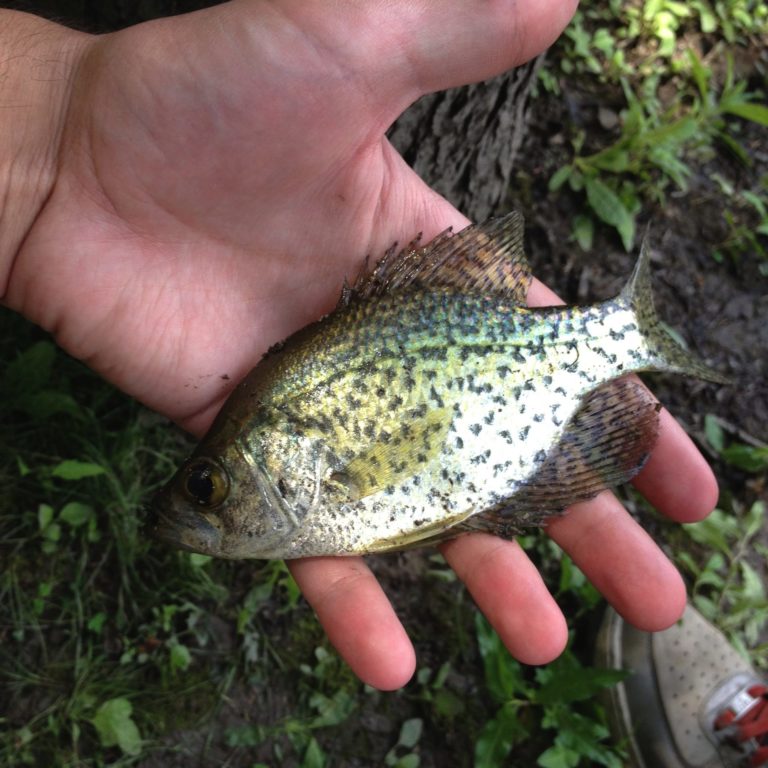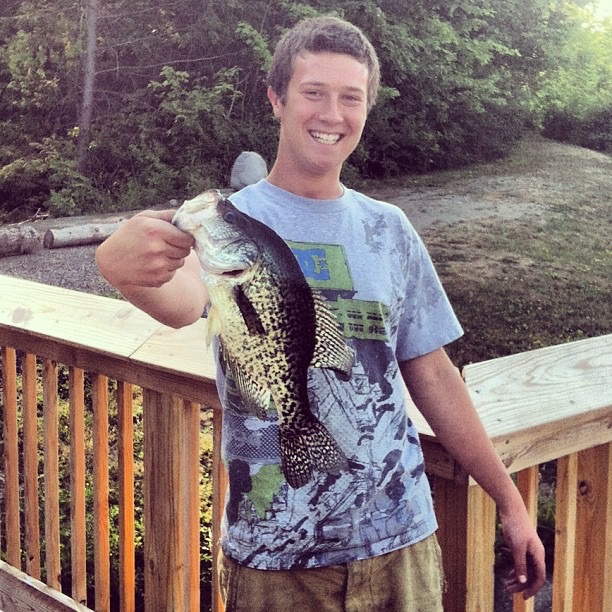The Black Crappie

The black crappie (Pomoxis nigromaculatus) is a warm-water “panfish” found throughout western New York. Black crappie typically range between 7 and 12 inches in length and have a broad body that is silver with numerous black splotches. Black crappie are popular among anglers because they are quite tasty.
Black crappie closely resemble their cousin, the white crappie, which is also present throughout western New York but to a more limited extent. There are a few subtle differences that distinguish black from white crappie, but they are usually difficult to tell apart. One difference between black and white crappie is the number of spines in the dorsal fin. Black crappie have about 7 dorsal spines, while white crappie have about 5. Also, white crappie usually have a lighter body with a more dull green hue, especially toward the dorsal area. In addition, the black splotches found on a white crappie typically form a more ordered, vertically banded pattern, while the black splotches on black crappie are random.
Habitat
Black crappie are warm-water fish, meaning they are tolerant of water temperatures greater than 70 °F in the summer. Crappie are usually found in ponds and lakes, but can sometimes be found in slow moving, warm-water creeks and rivers. This is not to say that crappie can’t inhabit cold-water creeks, it is just less likely to find them there.
In lakes and ponds, smaller crappie may inhabit weedy areas closer to shore, intermingling with the bluegill and pumpkinseeds. Larger crappie are usually found outside of weed edges or in the open water, especially in ponds where they are a top predator. In lakes, crappie in deeper water will tend to congregate around structure, such as weed beds or submerged rocks or trees. In the springtime when lake temperatures are cold, large crappie can be found in schools close to shore. Crappie are generally not top predators in large lakes.
Food
Small crappie seem to enjoy feeding on insects including worms and aquatic insect larvae. From experience, larger crappie seem to enjoy feeding on minnows or other small panfish. Crappie will also eat crayfish if they are available.
Where to Catch Black Crappie
Black crappie are quite common and can be found in every county in western New York. Black crappie are usually stocked in ponds and lakes in neighborhoods and public parks. The wide distribution of black crappie attests to their adaptability, and black crappie have no problem establishing a naturally reproducing population in most bodies of water.
Although crappie can be caught year-round, the best time of year to fish for crappie in lakes and ponds is in the spring, particularly in the “ice out” period, when temperatures warm and ice is melting or has just melted. More generally, March through April is a good time to target crappie on most bodies of water. Crappie can also provide excellent ice fishing opportunities on many lakes and ponds.
In western New York, there are some standout lakes where big slab crappies are almost abundant. One such lake is Chautauqua Lake, where big crappies can be caught one after another. The most productive time to fish Chautauqua Lake for crappie is the spring, especially during ice out. Although big lakes like Chautauqua generally produce bigger crappie, your local pond can occasionally produce a few slabs. Below is a big crappie caught at a local pond on a minnow.

How to Catch Black Crappie
Crappie can be caught on both live and artificial bait. Productive artificial baits include curly-tail grubs fished on a jig head, tube jigs, or other soft plastics resembling worms or minnows. Large crappies will sometimes even attack crankbaits resembling minnows. When fishing curly-tail grubs or soft plastics, it is best to cast out far into the pond or lake, allow the bait to sink a bit, and then retrieve the bait continuously while jerking it to give it action.
Live bait is probably the easiest way to catch crappie. Minnows 2-3” in size fished under a float with a small split shot to add weight will typically produce nice crappie. Marabou or even bucktail jigs tipped with wax worms or nightcrawlers are also productive. When fishing live bait, a regular bobber or slip float can be used. The main advantage to using a slip float is you are able to get your bait down much deeper than you could when using a regular bobber.
